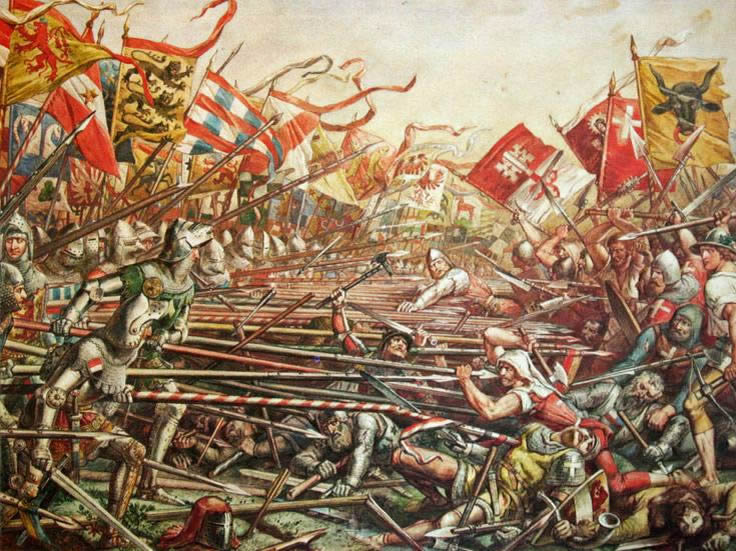 |
| Battle between Austria and the Swiss Confederacy |
Modern Switzerland dates from 1848. Previously, its government was based on an agreement or confederacy among three Swiss cantons in 1291. Between the 11th and 13th centuries, new technology had opened up Alpine passes and with this, trade appeared.
This whetted the appetite of ambitious dynasties, especially the Habsburgs, based originally in northern and central Switzerland, to attempt to control the trade, which meant control of the cantons.
In response, the rural forested cantons of Uri and Schwyz (from which the name Switzerland derives), which had received judicial autonomy from neighboring counts and dukes and were directly under the Holy Roman Empire (Germany, northern Italy, Bohemia, the Low Countries, and parts of eastern France) joined, with the district of Unterwalden to form the confederacy.
  |
They felt threatened by the encroaching Habsburg power and joined to defend one another. Victories at Morgarten (1315), Sempach (1386), and Nafels (1388) caused the Habsburgs basically to abandon their designs on Switzerland and concentrate on their new seat of power in Austria.
The military successes encouraged the expansion of the confederacy or confederation beyond its rural forested core during the 14th century, including the cities of Luzerne/Lucerne, Zurich, and Berne, so that by 1400 there were eight members and by 1460 much of what is now northern and central Switzerland was included. By that date, the confederacy had reached the Rhine.
The golden age of the confederacy came between 1475 and 1515. It was instrumental in the defeat of Charles of Burgundy, who aspired to reestablish a middle kingdom between France and Germany. In 1499, it received de facto if not de jure independence from the Empire (Germany).
Its initial success in the Italian wars added towns in southern Switzerland such as Lugano and Locarno under the confederacy. After their defeat by the French at Marignan in 1515, the confederacy ceased to be a major military power, although individual Swiss acted as mercenaries for centuries. By this time, there were 13 members, including Basle.
Three Centuries of No Expansion
For the next three centuries, there was no official expansion of the old Swiss Confederacy, although French-speaking districts in southwestern Switzerland, such as Fribourg, Geneva, Vaud, and Valais, were in alliance with it, as was the partly French-speaking Neuchâtel. In addition, the partly Italian-speaking canton of Grisons in the southeast, as well as the Italian-speaking Ticino, became associated with the Swiss confederation.
In 1648 the Swiss Confederacy received the formal recognition of its independence from the Empire. Ultimately, the French-speaking areas that had been associated with the confederacy entered as full cantons after the Napoleonic Wars, in 1815.
At the same time, Grisons and the Italian-speaking areas that had been subordinate to the older Swiss cantons received full rights and were admitted as equal cantons with splits in existing cantons raising the total to the present 22. It was at this time that the country became officially known as Switzerland.
At this date, the country achieved its present frontiers and went from an exclusively German-speaking land to a country in which approximately 30 percent of the population was French- and Italian-speaking and on equal terms with the German majority.
Nonetheless, the country remained a confederacy or confederation in structure. Each canton had its own form of government whether democratic, oligarchic, or absolute; each could impose its own internal customs duties; and each could make its own alliances within and without the confederacy.
As a result, tensions ran high during the period of 1815 to 1847 between the liberal, urban and mostly Protestant cantons and the traditional rural and mostly Catholic cantons. Eventually, disagreement came to a head when the Catholic cantons objected to the suppression of the monasteries and formed an alliance called the Sonderbund (after its seven members).
The federal diet declared this alliance a violation of the 1815 constitution and war broke out. The Sonderbund was defeated, and in 1848 a new constitution was adopted that had the effect of ending the old structure of the confederacy.
Two Chamber Assembly
In place of the old Swiss Confederacy diet composed of representatives of the cantons, there was a two-chamber assembly, with one chamber composed of representatives of the people and the other chamber composed of representatives of the cantons. (It was modeled on the U.S. system.)
Unlike the old confederacy, there was a relatively strong executive chosen at the federal level called the Federal Council. It was composed of seven members chosen by the assembly for three years and not by the cantons.
Also unlike the old Confederacy, economic power was placed at the center so that individual cantons could no longer make separate economic arrangements. Changes in the constitution and other matters of national interest were decided by plebiscite and referendum voted on by all of the citizens not through the decisions of various cantons as in confederacy days.
The Swiss Confederacy lasted from 1291 to 1848. It came into existence as the result of new economic and political developments in the High Middle Ages; it ended because of new economic and political developments associated with the evolution of the nation-state in modern times. The old confederacy with 13 cities and small village communities dominating a country was no longer feasible.